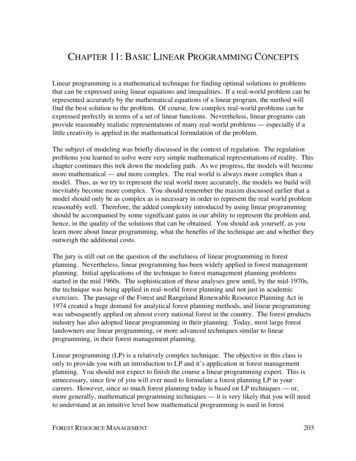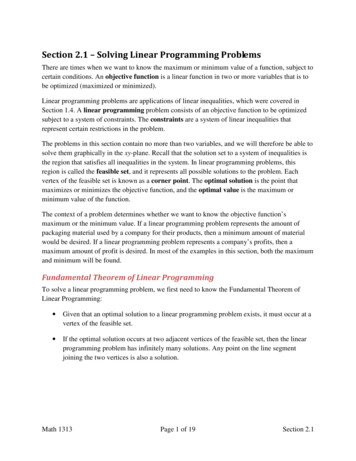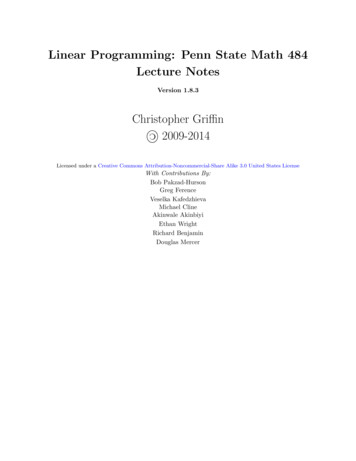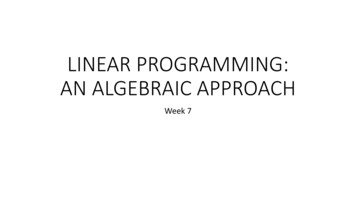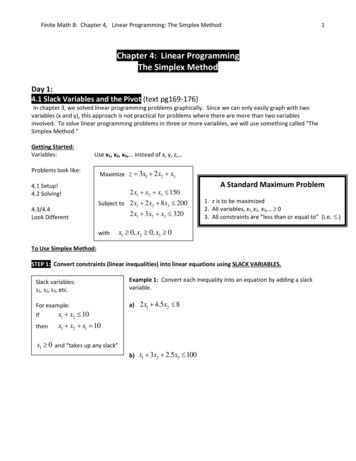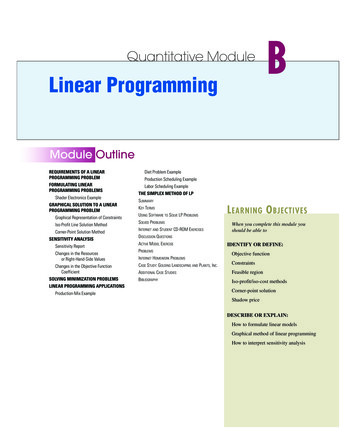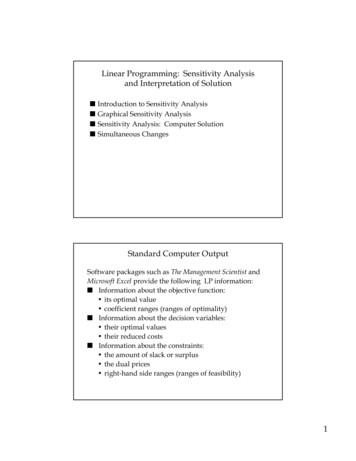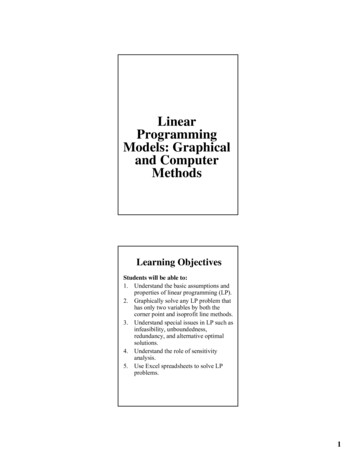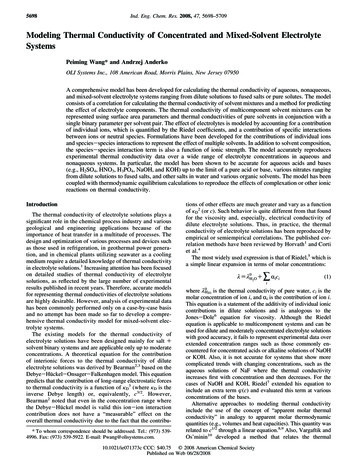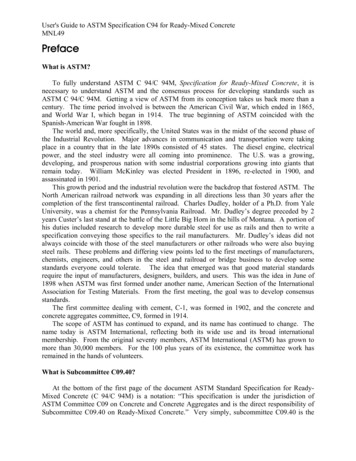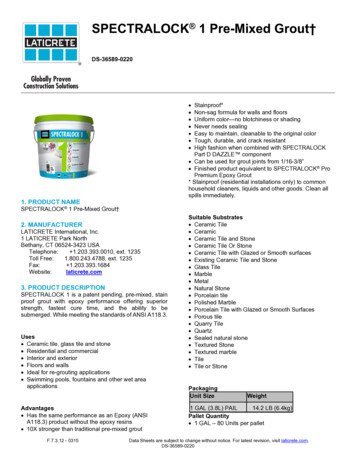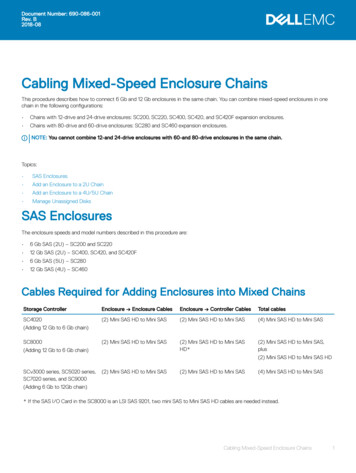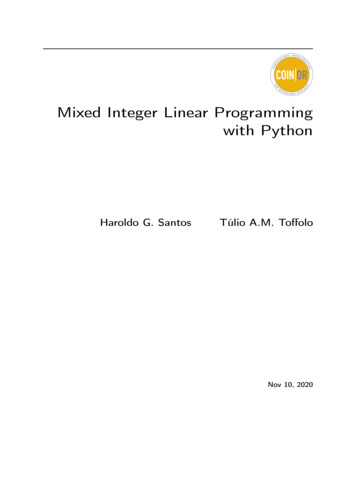
Transcription
Mixed Integer Linear Programmingwith PythonHaroldo G. SantosTúlio A.M. ToffoloNov 10, 2020
Contents:1 Introduction1.1 Acknowledgments . . . . . . . . . . . . . . . . . . . . . . . . . . . . . . . . . . . . . . . .112 Installation2.1 Gurobi Installation and Configuration (optional) . . . . . . . . . . . . . . . . . . . . . . .2.2 Pypy installation (optional) . . . . . . . . . . . . . . . . . . . . . . . . . . . . . . . . . . .2.3 Using your own CBC binaries (optional) . . . . . . . . . . . . . . . . . . . . . . . . . . .33343 Quick start3.1 Creating Models . . . . . . . . . . . . . . . . . .3.1.1 Variables . . . . . . . . . . . . . . . . . .3.1.2 Constraints . . . . . . . . . . . . . . . .3.1.3 Objective Function . . . . . . . . . . . .3.2 Saving, Loading and Checking Model Properties3.3 Optimizing and Querying Optimization Results3.3.1 Performance Tuning . . . . . . . . . . .555667784 Modeling Examples4.1 The 0/1 Knapsack Problem . . . . . . . . . . . . . . . .4.2 The Traveling Salesman Problem . . . . . . . . . . . . .4.3 n-Queens . . . . . . . . . . . . . . . . . . . . . . . . . .4.4 Frequency Assignment . . . . . . . . . . . . . . . . . . .4.5 Resource Constrained Project Scheduling . . . . . . . .4.6 Job Shop Scheduling Problem . . . . . . . . . . . . . .4.7 Cutting Stock / One-dimensional Bin Packing Problem4.8 Two-Dimensional Level Packing . . . . . . . . . . . . .4.9 Plant Location with Non-Linear Costs . . . . . . . . . .991013141619212225.5 Special Ordered Sets6 Developing Customized Branch-&-Cut6.1 Cutting Planes . . . . . . . . . . . . .6.2 Cut Callback . . . . . . . . . . . . . .6.3 Lazy Constraints . . . . . . . . . . . .6.4 Providing initial feasible solutions . .29algorithms. . . . . . . . . . . . . . . . . . . . . . . . . . . . .31313436377 Benchmarks397.1 n-Queens . . . . . . . . . . . . . . . . . . . . . . . . . . . . . . . . . . . . . . . . . . . . . 398 External Documentation/Examples419 Classes439.1 Model . . . . . . . . . . . . . . . . . . . . . . . . . . . . . . . . . . . . . . . . . . . . . . . 439.2 LinExpr . . . . . . . . . . . . . . . . . . . . . . . . . . . . . . . . . . . . . . . . . . . . . . 53i
.179.189.19LinExprTensor . . .Var . . . . . . . . .Constr . . . . . . .Column . . . . . . .ConflictGraph . . .VarList . . . . . . .ConstrList . . . . .ConstrsGenerator .IncumbentUpdater .CutType . . . . . .CutPool . . . . . . .OptimizationStatusSearchEmphasis . .LP Method . . . .ProgressLog . . . .Exceptions . . . . .Useful functions . ython Module Index65Index67ii
Chapter 1IntroductionThe Python-MIP package provides tools for modeling and solving Mixed-Integer Linear ProgrammingProblems (MIPs) [Wols98] in Python. The default installation includes the COIN-OR Linear Programming Solver - CLP, which is currently the fastest open source linear programming solver and theCOIN-OR Branch-and-Cut solver - CBC, a highly configurable MIP solver. It also works with the stateof-the-art Gurobi MIP solver. Python-MIP was written in modern, typed Python and works with thefast just-in-time Python compiler Pypy.In the modeling layer, models can be written very concisely, as in high-level mathematical programminglanguages such as MathProg. Modeling examples for some applications can be viewed in Chapter 4 .Python-MIP eases the development of high-performance MIP based solvers for custom applicationsby providing a tight integration with the branch-and-cut algorithms of the supported solvers. Strongformulations with an exponential number of constraints can be handled by the inclusion of Cut Generatorsand Lazy Constraints. Heuristics can be integrated for providing initial feasible solutions to the MIPsolver. These features can be used in both solver engines, CBC and GUROBI, without changing a singleline of code.This document is organized as follows: in the next Chapter installation and configuration instructionsfor different platforms are presented. In Chapter 3 an overview of some common model creation andoptimization code included. Commented examples are included in Chapter 4 . Chapter 5 includes somecommon solver customizations that can be done to improve the performance of application specificsolvers. Finally, the detailed reference information for the main classes is included in Chapter 6 .1.1 AcknowledgmentsWe would like to thank for the support of the Combinatorial Optimization and Decision Support (CODeS)research group in KU Leuven through the senior research fellowship of Prof. Haroldo in 2018-2019,CNPq “Produtividade em Pesquisa” grant, FAPEMIG and the GOAL research group in the ComputingDepartment of UFOP.1
Mixed Integer Linear Programming with Python2Chapter 1. Introduction
Chapter 2InstallationPython-MIP requires Python 3.5 or newer. Since Python-MIP is included in the Python Package Index,once you have a Python installation, installing it is as easy as entering in the command prompt:pip install mipIf the command fails, it may be due to lack of permission to install globally available Python modules.In this case, use:pip install mip --userThe default installation includes pre-compiled libraries of the MIP Solver CBC for Windows, Linuxand MacOS. If you have the commercial solver Gurobi installed in your computer, Python-MIP willautomatically use it as long as it finds the Gurobi dynamic loadable library. Gurobi is free for academicuse and has an outstanding performance for solving MIPs. Instructions to make it accessible on differentoperating systems are included bellow.2.1 Gurobi Installation and Configuration (optional)For the installation of Gurobi you can look at the Quickstart guide for your operating system. PythonMIP will automatically find your Gurobi installation as long as you define the GUROBI HOME environmentvariable indicating where Gurobi was installed.2.2 Pypy installation (optional)Python-MIP is compatible with the just-in-time Python compiler Pypy. Generally, Python code executesmuch faster in Pypy. Pypy is also more memory efficient. To install Python-MIP as a Pypy package,just call (add --user may be necessary also):pypy3 -m pip install mip3
Mixed Integer Linear Programming with Python2.3 Using your own CBC binaries (optional)Python-MIP provides CBC binaries for 64 bits versions of MacOS, Linux and Windows that run on Intelhardware. These binaries may not be suitable for you in some cases:a) if you plan to use Python-MIP in another platform, such as the Raspberry Pi, a 32 bits operatingsystem or FreeBSD, for example;b) if you want to build CBC binaries with special optimizations for your hardware, i.e., using the-march native option in GCC, you may also want to enable some optimizations for CLP, such asthe use of the parallel AVX2 instructions, available in modern hardware;c) if you want use CBC binaries built with debug information, to help elucidating some bug.In the CBC page page there are instructions on how to build CBC from source on Unix like platforms andon Windows. Coinbrew is a script that makes it easier the task of downloading and building CBC and itsdependencies. The commands bellow can be used to download and build CBC on Ubuntu Linux, slightlydifferent packages names may be used in different distributions. Comments are included describing somepossible customizations.# install dependencies to buildsudo apt-get install gcc g gfortran libgfortran-9-dev liblapack-dev libamd2 libcholmod3 libmetis-dev libsuitesparse-dev libnauty2-dev git# directory to download and compile CBCmkdir -p /build ; cd /build# download latest version of coinbrewwget -nH /master/coinbrew# download CBC and its dependencies with coinbrewbash coinbrew fetch Cbc@master --no-prompt# build, replace prefix with your install directory, add --enable-debug if necessarybash coinbrew build Cbc@master --no-prompt --prefix /home/haroldo/prog/ --tests none --enable cbc-parallel --enable-relocatablePython-MIP uses the CbcSolver shared library to communicate with CBC. In Linux, this file is namedlibCbcSolver.so, in Windows and MacOS the extension should be .dll and .dylp, respectively. Toforce Python-MIP to use your freshly compiled CBC binaries, you can set the PMIP CBC LIBRARY environment variable, indicating the full path to this shared library. In Linux, for example, if you installedyour CBC binaries in /home/haroldo/prog/, you could use:export PMIP CBC LIBRARY "/home/haroldo/prog/lib/libCbcSolver.so"Please note that CBC uses multiple libraries which are installed in the same directory. You may also needto set one additional environment variable specifying that this directory also contains shared librariesthat should be accessible. In Linux and MacOS this variable is LD LIBRARY PATH, on Windows the PATHenvironment variable should be set.export LD LIBRARY PATH "/home/haroldo/prog/lib/": LD LIBRARY PATHIn Linux, to make these changes persistent, you may also want to add the export lines to your .bashrc.4Chapter 2. Installation
Chapter 3Quick startThis chapter presents the main components needed to build and optimize models using Python-MIP. Afull description of the methods and their parameters can be found at Chapter 4 .The first step to enable Python-MIP in your Python code is to add:from mip import *When loaded, Python-MIP will display its installed version:Using Python-MIP package version 1.6.23.1 Creating ModelsThe model class represents the optimization model. The code below creates an empty Mixed-IntegerLinear Programming problem with default settings.m Model()By default, the optimization sense is set to Minimize and the selected solver is set to CBC. If Gurobi isinstalled and configured, it will be used instead. You can change the model objective sense or force theselection of a specific solver engine using additional parameters for the constructor:m Model(sense MAXIMIZE, solver name CBC) # use GRB for GurobiAfter creating the model, you should include your decision variables, objective function and constraints.These tasks will be discussed in the next sections.3.1.1 VariablesDecision variables are added to the model using the add var() method. Without parameters, a singlevariable with domain in R is created and its reference is returned:x m.add var()By using Python list initialization syntax, you can easily create a vector of variables. Let’s say that yourmodel will have n binary decision variables (n 10 in the example below) indicating if each one of 10items is selected or not. The code below creates 10 binary variables y[0], . . . , y[n-1] and stores theirreferences in a list.n 10y [ m.add var(var type BINARY) for i in range(n) ]5
Mixed Integer Linear Programming with PythonAdditional variable types are CONTINUOUS (default) and INTEGER. Some additional properties that can bespecified for variables are their lower and upper bounds (lb and ub , respectively), and names (propertyname ). Naming a variable is optional and it is particularly useful if you plan to save you model (seeSaving, Loading and Checking Model Properties) in .LP or .MPS file formats, for instance. The followingcode creates an integer variable named zCost which is restricted to be in range { 10, . . . , 10}. Note thatthe variable’s reference is stored in a Python variable named z.z m.add var(name 'zCost', var type INTEGER, lb -10, ub 10)You don’t need to store references for variables, even though it is usually easier to do so to writeconstraints. If you do not store these references, you can get them afterwards using the Model functionvar by name() . The following code retrieves the reference of a variable named zCost and sets its upperbound to 5:vz m.var by name('zCost')vz.ub 53.1.2 ConstraintsConstraints are linear expressions involving variables, a sense of , or for equal, less or equal andgreater or equal, respectively, and a constant. The constraint 𝑥 𝑦 10 can be easily included withinmodel m:m x y 10Summation expressions can be implemented with the function xsum() . If for a knapsack problem with 𝑛items, each one with weight 𝑤𝑖 , we would like to include a constraint to select items with binary variables𝑥𝑖 respecting the knapsack capacity 𝑐, then the following code could be used to include this constraintwithin the model m:m xsum(w[i]*x[i] for i in range(n)) cConditional inclusion of variables in the summation is also easy. Let’s say that only even indexed itemsare subjected to the capacity constraint:m xsum(w[i]*x[i] for i in range(n) if i%2 0) cFinally, it may be useful to name constraints. To do so is straightforward: include the constraint’s nameafter the linear expression, separating it with a comma. An example is given below:m xsum(w[i]*x[i] for i in range(n) if i%2 0) c, 'even sum'As with variables, reference of constraints ca
Mixed Integer Linear Programming with Python 2.3UsingyourownCBCbinaries(optional) cOS,LinuxandWindowsthatrunonIntel
